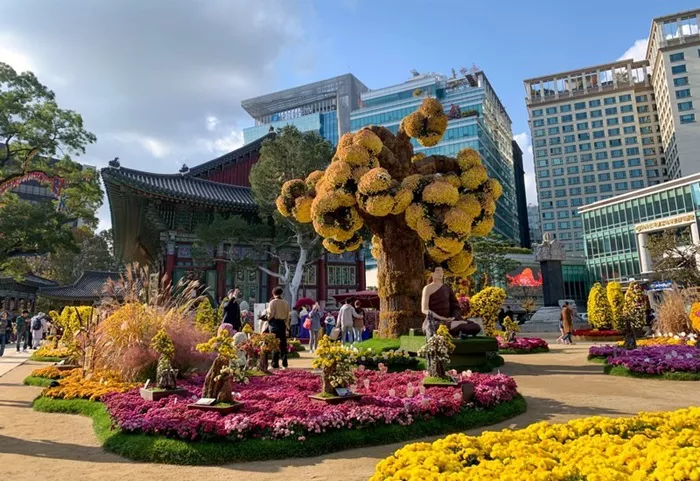Jogyesa Temple is one of the most famous Buddhist temples in South Korea. It is the chief temple of the Jogye Order, which is the largest sect of Korean Buddhism. The temple is located in the heart of Seoul, the capital city. Many visitors come to Jogyesa Temple to learn about Korean Buddhist culture, meditate, and enjoy its beautiful surroundings.
History of Jogyesa Temple
Early Beginnings
Jogyesa Temple was originally built in 1395 during the Joseon Dynasty. At that time, it was called Gakhwangsa Temple. Over the centuries, the temple experienced damage from wars and fires. Despite this, it remained an important place for Buddhist practice in Korea.
Modern Era and Reconstruction
In 1910, during the Japanese occupation of Korea, Jogyesa Temple was renamed and rebuilt. The current name, Jogyesa, comes from Mount Jogye, a famous mountain where many Zen (Seon) masters practiced meditation. The temple became the headquarters of the Jogye Order, promoting Seon Buddhism.
Role in Korean Buddhism
Today, Jogyesa Temple is the center of Korean Zen Buddhism. It hosts many cultural and religious events. The temple also supports Buddhist education and charity activities. Because of its importance, Jogyesa is often visited by both Buddhists and tourists.
Significance of Jogyesa Temple
Religious Importance
Jogyesa Temple holds a central place in Korean Buddhism. It is a symbol of the Jogye Order, which focuses on meditation and Buddhist teachings. Many monks and laypeople gather here to pray, meditate, and celebrate Buddhist festivals.
Architectural and Artistic Value
The temple buildings show classic temple architecture styles of Korea. Colorful paintings, wooden carvings, and intricate roof designs reflect traditional Buddhist art. The temple also houses a large statue of Buddha, which is an important object of worship.
Cultural and Social Role
Jogyesa Temple acts as a cultural hub in Seoul. It hosts events such as the Lotus Lantern Festival, which celebrates Buddha’s birthday. Visitors can experience traditional Buddhist ceremonies, tea ceremonies, and meditation sessions. The temple also supports social welfare programs, helping local communities.
Exploring Jogyesa Temple
Main Buildings and Features
The temple complex includes several key buildings. The Daeungjeon Hall is the main prayer hall, where the Buddha statue sits. Nearby, you will find the Geungnakjeon Hall and the Buddhist museum. The temple garden is peaceful, filled with trees and flowers that change with the seasons.
Notable Statues and Artworks
Inside the main hall, a large golden Buddha statue commands respect. Around it, colorful murals depict scenes from Buddha’s life. Visitors often pause here for quiet reflection. The temple also has statues of Bodhisattvas, who represent compassion and wisdom in Buddhism.
Temple Grounds and Surroundings
The grounds are carefully maintained to promote peace and calm. Visitors can walk along stone paths shaded by old trees. During spring, the temple’s lotus flowers bloom beautifully. In autumn, the leaves turn bright red and yellow, creating a stunning view.
Visitor Guide to Jogyesa Temple
Location and Access
Jogyesa Temple is located in Jongno-gu, Seoul. It is easy to reach by subway or bus. The nearest subway station is Jonggak Station, just a short walk from the temple entrance. The temple is open year-round and welcomes visitors every day.
Opening Hours and Admission
The temple grounds are free to enter. The main prayer halls are usually open from early morning until evening. It is best to check the temple’s official website for special events or schedule changes. Visitors are encouraged to dress modestly and speak quietly to respect the temple atmosphere.
Things to Do at Jogyesa Temple
Join a Buddhist Ceremony
Visitors can take part in daily chanting and prayer sessions. These ceremonies often include meditation and the ringing of a large bell. It is a good chance to experience Korean Buddhist worship firsthand.
Explore the Temple Museum
The Buddhist museum near the temple offers exhibitions on Buddhist history and culture. It displays ancient scriptures, ritual objects, and temple artifacts.
Participate in Temple Stay Programs
Jogyesa Temple offers Temple Stay programs for those who want to experience monastic life. Participants learn meditation, Buddhist ethics, and temple etiquette. It is a peaceful retreat from city life and a way to understand Buddhism deeply.
Enjoy the Lotus Lantern Festival
Each year, Jogyesa hosts the Lotus Lantern Festival to celebrate Buddha’s birthday. The temple is decorated with colorful lanterns, and there are parades and cultural performances. This is one of the most vibrant times to visit.
Tips for Visitors
- Wear comfortable shoes for walking around the temple grounds.
- Respect the temple rules: no loud talking, no photography inside prayer halls.
- Try to visit early in the morning or late afternoon to avoid crowds.
- Bring a small donation if you wish to support the temple’s activities.
Understanding Buddhist Architecture at Jogyesa
Jogyesa Temple is a fine example of traditional Korean buddhist architecture. The buildings have curved tiled roofs with upturned corners. These are designed to bring a sense of lightness and grace. Wooden beams and pillars are painted with bright colors and patterns, which have symbolic meanings in Buddhism.
The layout of the temple follows Buddhist principles. The main hall faces east, symbolizing enlightenment and the rising sun. Courtyards and gardens create a flow that encourages meditation and inner peace. This architecture is not just for beauty but helps visitors feel calm and focused.
Conclusion
Jogyesa Temple is much more than a religious site. It is a cultural treasure that teaches visitors about Korean Buddhism and traditional arts. Whether you come for spiritual practice, sightseeing, or cultural experience, Jogyesa offers something meaningful. It stands as a living symbol of Buddhism’s lasting influence in Korea and the world.

